It was around 1812 that John Whittred purchased a modest farm in Long Street from John Wiggett. The premises comprised a house with a barn, stable, yard and garden. The purchase also included some 30 acres of land.
Much later, this farm became known as Cemetery Farm and, in more recent times, Home Farm. However for ease of reference I refer to the farm as Cemetery Farm whether or not it was known by that name at the time.
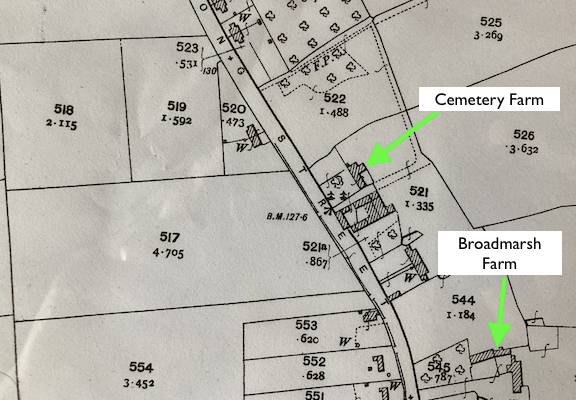
Extract from 1906 Ordnance Survey Map. Second Edition. Surveyed in 1881. Revised 1904.
John Whittred lived at Cemetery Farm along with his wife Elizabeth and their daughter, also named Elizabeth. Young Elizabeth was born in Great Fransham in 1807, a few years before the family moved to Great Ellingham.
John Whittred Mortgages Cemetery Farm
On the 30th November, 1830, John Whittred borrows the sum of £600 from merchant, John Burlingham of Old Buckenham. Whittred agrees to pay interest at the rate of £4 10s per centum per annum. The loan is secured against Cemetery Farm.
It may be that the reason for the loan is to fund John Whittred’s purchase of the neighbouring farm in the following year.
Purchase of Brooke’s Farm
Robert Brooke owned and occupied the neighbouring farm. However he died in 1829.
The property was also occupied by a person with the last name of ‘Allison’. Brooke inherited the farm from his father, Robert Brooke senior, who died in Great Ellingham in 1820. For ease of reference, I refer to this farm as Brooke’s Farm.
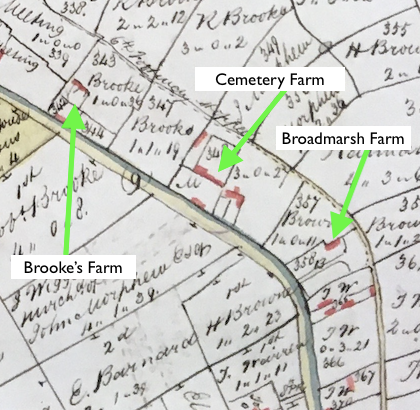
Extract from 1802 Map of Great Ellingham. Russell James Colman Plans. Norfolk Record Office Cat. Ref. C/Ca 1/84.
All rights reserved Norfolk Record Office. With kind permission of NRO
Freehold & Copyhold
Whilst the majority of Brooke’s Farm was freehold, parts of the land were copyhold of the Manors of Buckenham Lathes Outsoken, Buckenham Castle Outsoken, Ellingham Hall and Ellingham Rectory.
I have indicated the position of Brooke’s farm on the above extract from the 1802 Great Ellingham Inclosure Map.
Brooke Family Ownership
The farm had been in the ownership of the Brooke family since at least 1700.
In about 1741, Robert Brooke senior inherited the property from his late grandfather, Joseph Brooke. At the time, Robert Brooke had not yet reached his 10th birthday. For some reason, Joseph Brooke decided to leave the property to his young grandson, and not to his own son Joseph (young Joseph’s father).
Earlier Messuage
At the turn of the 19th century, the extent of the premises and land owned by Robert Brooke senior, comprised one messuage (house with associated outbuildings and land), together with around 17 acres of land. George Cady occupied the house as well as the majority of the land. Robert Barnard occupied 5 acres and John Barnard 3 acres.
The premises also included ‘one messuage wasted’ together with over 3 acres of land all of which were copyhold of the Manor of Buckenham Lathes. Furthermore the ‘one messuage wasted’ appears in the Manor Court Books from at least 1701.
There may have been little evidence of this former building at the turn of the 19th century. Having said that, it may have been turned into a store or shelter for animals.
Mortgages
In 1769 and 1774, Robert Brooke borrows £400 plus interest from William Bowles. The debt is secured against Brooke’s property.
In 1803, the debt is assigned to Richard Bowles. It is fully repaid by the time the property is sold to John Whittred.
Sale by Executor
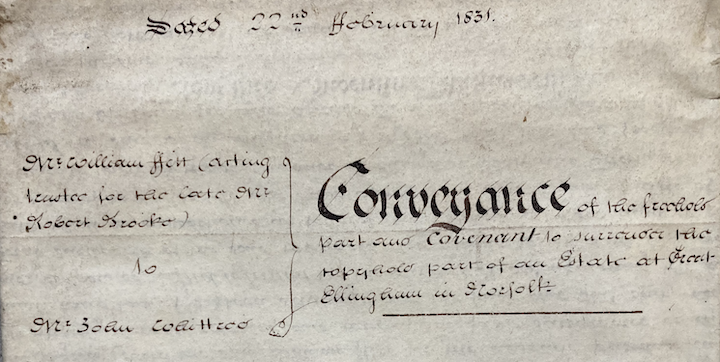
Extract from the Conveyance dated 22 February 1831 between William Fitt and John Whittred
Courtesy David & Julia Matthews
On the 22nd February, 1831, William Fitt, a fowl man of Ovington, Norfolk, acting as the executor of the late Robert Brooke, sold Brooke’s farm to John Whittred. The purchase price totalled £600. This comprised £440 being paid for the freehold parts, £100 for the parts which were copyhold of the Manor of Buckenham Lathes, £30 for the copyhold land of Ellingham Hall and £30 for the copyhold land of Ellingham Rectory.

Extract from the Conveyance dated 22 February 1831 between William Fitt and John Whittred
Courtesy David & Julia Matthews
The farm consisted of a messuage or tenement with a barn, stable, yard, garden and orchard and several pieces of land amounting to just over 11 acres. It had recently been occupied by Robert Buscall (Buskell). However John Whittred had already taken up occupation.
Nevertheless, John Whittred may well have remained living at Cemetery Farm and let the former ‘Brooke’s Farm’ to a tenant or used it to house an employee.
John Whittred uses Brooke’s Farm as Security for Loan
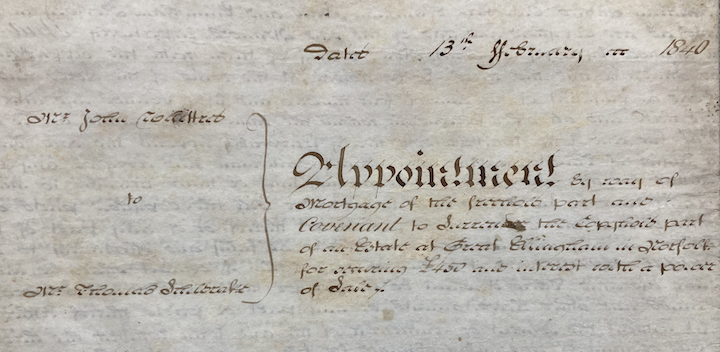
Extract from Deed of Appointment by way of Mortgage 13 February 1840 John Whittred to Thomas Shildrake
Courtesy David & Julia Matthews
On the 13th February, 1840, John Whittred borrows the sum of £450 from Thomas Shildrake of Norwich. Whittred’s son-in-law, William Kiddle Warren, was also party to the deed.

Extract from Deed of Appointment by way of Mortgage 13 February 1840 John Whittred to Thomas Shildrake
Courtesy David & Julia Matthews
Shildrake paid the £450 to both John Whittred and William Kiddle Warren (described as a farmer of Roydon). I wonder whether Whittred raised the borrowing for his son-in-law. We have already ‘met‘ William Kiddle Warren in various other articles.
Nevertheless Whittred secured the borrowing against Brooke’s Farm. The security also included a number of cottages and buildings “lately built” on the premises.
Unfortunately the majority of early conveyance deeds do not have plans – as is the case here. Accordingly, one can only rely on the description of the property which, in this instance, is not particularly clear.
Nevertheless, I wonder whether Whittred had commissioned the building of two semi-detached cottages to the west of the farmhouse of Brooke’s Farm, near to the road we now today as Long Street. However, this may not be the case. Alternatively the ‘lately built cottages and buildings’ are those cottages to the south of Cemetery Farm.
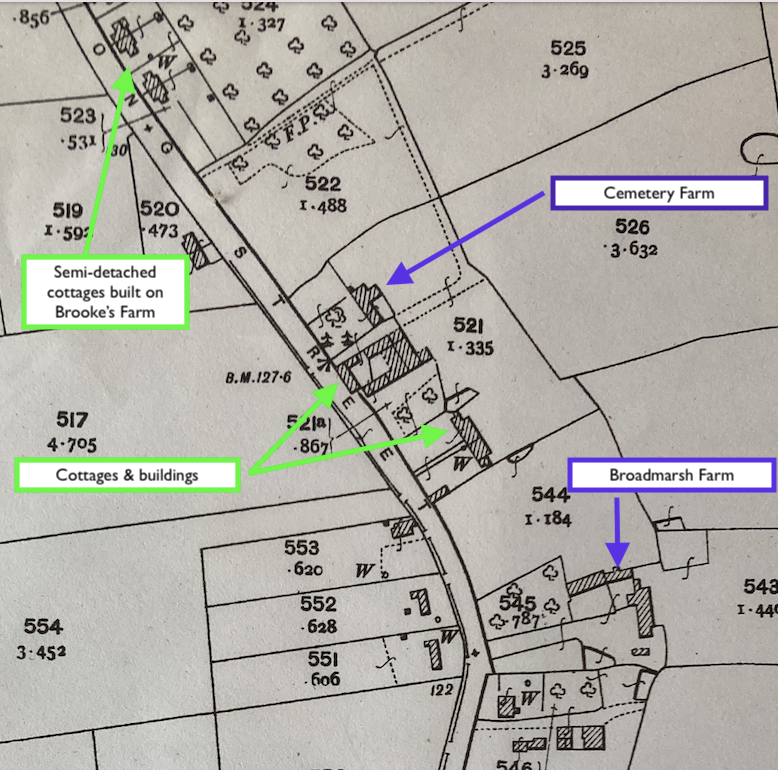
Extract from 1906 Ordnance Survey Map. Second Edition. Surveyed in 1881. Revised 1904.
The above extract from a much later Ordnance Survey map from a survey in 1881, shows the position of the two semi-detached cottages. These cottages were built on land formerly owned by Robert Brooke.
However, at the time of the survey in 1881, the farmhouse formerly owned by the Brooke family (and then John Whittred), had disappeared.
The map also shows the position of further cottages and buildings to the south of Cemetery Farm.
Re-Conveyance of Cemetery Farm
By 1st February, 1840, John Whittred repaid his mortgage secured on Cemetery Farm.
Consequently on the 16th July, 1840, John Burlingham re-conveyed Cemetery Farm back to John Whittred. The conveyance deed recites that John Whittred had paid £631 11s 8d to fully discharge the principal debt plus the interest.
Death of John Whittred
At the time of the 1841 census, John and Elizabeth Whittred are still living in Cemetery Farm.
Earlier in 1828, their only daughter, Elizabeth, married William Kiddle Warren, the son of local farmer, Thomas Warren. The couple provided John and Elizabeth Whittred with three grandchildren. Jeremiah (born 1829), Joseph (1831) and Elizabeth (born 1834).
Nevertheless, the 1841 census captures Elizabeth Warren along with her nine year old son Joseph at her parents’ home in Long Street. Elizabeth Warren’s husband is absent. He is probably in Diss. Elizabeth’s eldest son, 12 year old Jeremiah, is with school master Goodwin Kilburn in Hackford cum Reepham. I cannot locate Elizabeth’s 7 year old daughter Elizabeth at this time.
John Whittred died on the 22nd June, 1841 aged 67 years. He was buried at East Bradenham on the 1st July.
John Whittred’s Will
On the 23rd March, 1841, John Whittred signed his last will and testament. He appointed farmer William Colman of Great Ellingham and Attleborough surgeon John Marner as his executors.
Real Estate
Widow Elizabeth Whittred inherited a life interest in her late husband’s messuages, cottages, lands and hereditaments in Great Ellingham. This, of course, included Cemetery Farm and Brooke’s Farm. The life tenancy is conditional in that Elizabeth must keep the premises in good and tenantable repair and insure them from loss or damage by fire.
After Elizabeth Whittred dies, her late husband’s properties pass to their daughter Elizabeth. Again this is limited to her lifetime. She is also to keep the premises in repair and insured. John Whittred also stated that the properties are for his daughter’s own and separate use – i.e. not under the control of her husband!
After the death of Elizabeth Warren, the ownership of the properties will pass to John Whittred’s grandson, Joseph Warren. At the time John Whittred signed his will, Joseph Warren is nine years old. Joseph would take the inheritance on reaching the age of 21. However should Joseph not reach the age of 21 and does not leave a ‘lawfully begotten’ heir, then the ownership of the properties will pass to his sister, Elizabeth Warren, again providing she reaches the age of 21. If this fails, then the properties will pass to their brother, Jeremiah.
Legacies
John Whittred left £500 each to grandchildren, Jeremiah and Elizabeth. I presume that Joseph will not receive £500 as he will inherit his grandfather’s properties.
Nevertheless, Jeremiah and Elizabeth will receive their £500 two months after the death of their mother, Elizabeth Warren. This is also providing they reach the age of 21.
Having said that, Elizabeth will receive her £500 if she has married, even if she has not then reached 21. Nevertheless, this would also be for her sole and separate use i.e. that it would not be in her husband’s control.
John Whittred makes it clear that the gifts of £500 are specific charges on all his real estate.
He leaves the remainder of his estate, which includes all goods, chattels, money, securities for money and all other of his personal estate and effects to his wife Elizabeth.
Elizabeth Whittred
Accordingly, widow Elizabeth Whittred became the next owner of Brooke’s Farm, Cemetery Farm, all the associated land and the ‘newly built’ cottages. Even though her ownership is limited to her lifetime, Elizabeth is still required to deal with the transfer to her of those parts of her late husband’s land which remained copyhold of several manors.
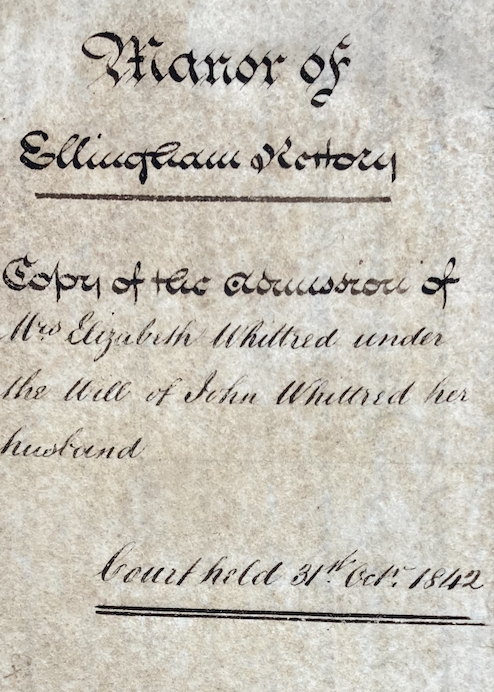
31st October 1842. Admission of Elizabeth Whittred as copyhold tenant of the Manor of Ellingham Rectory
Courtesy David & Julia Matthews
Great Ellingham Tithe Map
The Great Ellingham Tithe Map documentation of 16th December, 1843, shows Elizabeth Whittred as the owner of various pieces of land in Great Ellingham as well as a House & Garden within an area of 0a 2r 11p, a Homestall with Cottage 1a 2r 11p and House & Premises 0a 2r 20p.
The House & Garden is occupied by William Catchpole ‘& others’. I believe that Elizabeth Whittred and her daughter Elizabeth Warren is also occupying this dwelling. This is the farmhouse once owned by Robert Brooke.
The House & Premises is occupied by Robert Le Grice senior. This is Cemetery Farm.
The Homestall & Cottage is also occupied by Robert Le Grice senior. However, I suspect that Le Grice is sub-letting this property to tenants or his employees.
Unfortunately, the Tithe Map documentation does not specifically refer to the ‘lately built’ cottages referred to in the 1840 mortgage deed relating to Brooke’s Farm.
1851 census
The 1851 census captures 76 year old widow Elizabeth Whittred and her 42 year old married daughter Elizabeth Warren living in Long Street. Elizabeth Whittred’s occupation is ‘land owner’.
Also in Long Street is 58 year old Robert Le Grice with his 59 year old wife Mary and his 45 year old sister Mary Ann Le Grice. Robert Le Grice is farming some 52 acres and an employer of two labourers.
1861 census
Ten years later, 90 year old Elizabeth Whittred and her 51 year old daughter Elizabeth Warren are still living in Long Street.
Deaths of Elizabeth Whittred & Elizabeth Warren
Sadly, mother and daughter died within a year of each other. Elizabeth Whittred died on the 9th February, 1862. She was buried in the churchyard of St James on the 13th February. Her age is recorded as 89. This conflicts with her age given at the time of the census undertaken the previous year.
Elizabeth Warren was buried in the same churchyard on the 21st April, 1863. Her age is recorded as 57.
Both Elizabeth Whittred and Elizabeth Warren left wills. Nevertheless, the ownership of Cemetery Farm and Brooke’s Farm passes in accordance with John Whittred’s will of 23rd March, 1841.
Next Custodian
John Whittred’s grandson, Joseph Warren, became the next custodian of Cemetery Farm, the former Brooke’s Farm and all the cottages and buildings built upon nearby land.
Sources:
Private Property Deeds. Thanks to David & Julia Matthews
Great Ellingham Parish Registers. Norfolk Record Office PD 609. Also available via familysearch.org, www.ancestry.co.uk & other subscription websites
1799-1842 F W Horner, Records of the Surveyors to Commissioners for Inclosure in Parishes in Norfolk and Suffolk. Great Ellingham (Act 1799). Norfolk Record Office. Catalogue Ref: NRO, BR 90/2
1841 census HO107/781/8
Will of John Whittred. Viewed on microfilm at The Heritage Centre, Millennium Library, The Forum, Norwich. Reference 1842-1844 fo.11 (1842 No.8) ANW ANF 1818-1857. MF 250. GS0167180
16 December 1843. Great Ellingham Tithe Map. Tithe Apportionments, 1836-1929 [database online]. TheGenealogist.co.uk 2025. Original data: “IR29 Tithe Commission and successors: Tithe Apportionments” The National Archives.
1851 census HO107/1823/130 & HO107/1823/127
Manorial Court Rolls for Lathes, Close, Castle & Buckenham Priory 1595-1847. Microfilm Images viewed via www.familysearch.org. Original records Norfolk Record Office, Norwich.